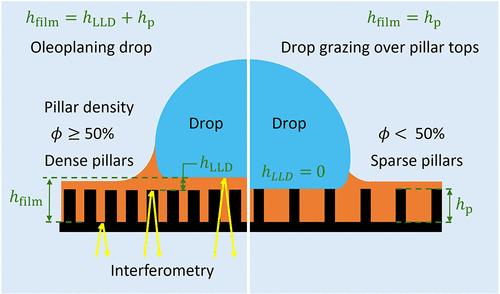滴摩擦的纹理润滑剂涂层表面
IF 8.2
2区 材料科学
Q1 MATERIALS SCIENCE, MULTIDISCIPLINARY
引用次数: 0
摘要
理解纹理表面上的水滴摩擦对微流体和芯片实验室设备具有重要意义。在这项工作中,我们通过系统地改变柱的高度和密度来研究润滑油涂层柱上的水滴摩擦。首先,我们使用灵敏度为±0.1 μN的悬臂式力传感器测量了运动液滴上的摩擦力。这一测量结果表明,在高而密的石柱上的雨滴摩擦与在短石柱上的雨滴摩擦相当,这一重要结果表明,在移动的石柱下方存在一层LLD膜。其次,利用白光干涉法估计润滑油层厚度,验证了测力结果。第三,我们使用反射干涉对比显微镜观察移动液滴下的润滑膜。这三种独立的诊断工具和测量技术相互补充,并重申了在高而密集的柱子上滴下的油面,同时它们在高而稀疏的柱子顶部擦过。迫使这种转变降低摩擦的临界密度≈50%。此外,实验结果表明,当固相分数相同时,微孔和微柱的摩擦具有可比性。这项研究的结果与过去报道的高矿柱上没有油层的研究相矛盾。除了提高当前的理解,从这项工作中获得的见解为微流体应用的需求提供了设计指南。本文章由计算机程序翻译,如有差异,请以英文原文为准。

Drop Friction on Textured Lubricant-Coated Surfaces
Understanding drop friction on textured surfaces has implications in microfluidics and lab-on-a-chip devices. In this work, we investigated the drop friction on lubricant-coated pillars by systematically varying pillar height and density. First, we measured the friction force on a moving drop using a cantilever force sensor that has ±0.1 μN sensitivity. This measurement shows that drop friction on tall dense pillars is comparable to drop friction on short pillars, a significant result that suggests the presence of a Landau–Levich–Derjaguin (LLD) film underneath the moving drop. Second, we validated the force measurement by estimating the lubricant layer thickness by using white-light interferometry. Third, we visualized the lubricant film underneath the moving drop using reflection interference contrast microscopy. The three independent diagnostic tools and measurement techniques complement each other and reaffirm that drops oleoplane on tall dense pillars, while they graze over the pillar tops in tall sparse pillars. The critical density that forces this transition to drop friction is ≈50%. Furthermore, the experimental results show that friction on microholes and micropillars is comparable when the solid fraction is the same. The results reported in this study contradict past studies that reported the absence of an oil layer on tall pillars. Besides improving current understanding, the insights gained from this work provide design guidelines for turning drop friction on–off on demand for microfluidics applications.
求助全文
通过发布文献求助,成功后即可免费获取论文全文。
去求助
来源期刊

ACS Applied Materials & Interfaces
工程技术-材料科学:综合
CiteScore
16.00
自引率
6.30%
发文量
4978
审稿时长
1.8 months
期刊介绍:
ACS Applied Materials & Interfaces is a leading interdisciplinary journal that brings together chemists, engineers, physicists, and biologists to explore the development and utilization of newly-discovered materials and interfacial processes for specific applications. Our journal has experienced remarkable growth since its establishment in 2009, both in terms of the number of articles published and the impact of the research showcased. We are proud to foster a truly global community, with the majority of published articles originating from outside the United States, reflecting the rapid growth of applied research worldwide.
 求助内容:
求助内容: 应助结果提醒方式:
应助结果提醒方式:


